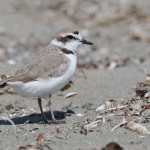Oregon Coast – The number of young western snowy plovers fledged on the Oregon Coast this year was the lowest since 2003.
In 2008, 71 young birds survived long enough to learn to fly and become independent of their parents. This number is down from the 124 young that survived during the same period last year.
There are eight plover nesting sites on the Oregon Coast from Sutton Beach to New River on Bureau of Land Management (BLM) and U.S. Forest Service managed land. “It’s normal for species populations to fluctuate from year to year over the long term,” said Dave Lauten, plover monitor with Oregon Natural Heritage Information Center. “Luckily the plovers have had a string of successful nesting years that got us through this tough year.”
Biologists speculate a number of factors worked together to make it a difficult year for the plovers. Cooler, wetter weather during the early months of the breeding season may have impacted the plover’s early season nesting. This year’s breeding population was also made up of younger birds that can be less successful due to inexperience.
Finally, biologists monitoring the plover populations noted lower success may also be an indication that predators are having an impact on chick survival. “Now more than ever, we need to assist these birds to meet population recovery goals,” said Kerrie Palermo, Wildlife Program Lead with the BLM. “A comprehensive management strategy is important. It helps with overall success and offsets losses due to natural factors, like weather.”
The comprehensive management strategy currently in place includes implementing temporary access closures on beaches during the nesting season, predator control, and habitat restoration.
The North Spit of Coos Bay continued to be the most productive nesting site. Forty of the 71 birds hatched this year came from the North Spit. “The North Spit continues to be important and successful habitat for the snowy plover, thanks in large part to the public’s willingness to comply with the area’s beach restrictions and the amount of restored habitat on BLM land,” said Palermo.
The western snowy plover is a small shorebird that lays its eggs and raises it young in the open dry sand. The Pacific coast population of the western snowy plover was listed by the U.S.
Fish and Wildlife Service as threatened in 1993. The primary threats to snowy plover survival are habitat degredation, urban development, introduced European beachgrass, and predators such as crows, ravens, foxes and skunks.
Please visit www.blm.gov for more information.
Disclaimer: Articles featured on Oregon Report are the creation, responsibility and opinion of the authoring individual or organization which is featured at the top of every article.



